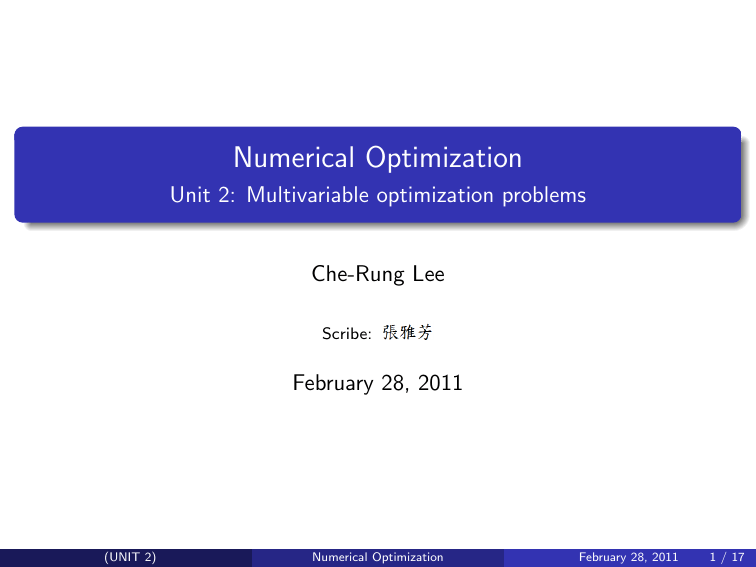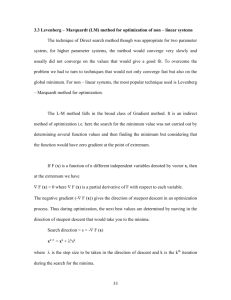Numerical Optimization - Unit 2: Multivariable optimization problems
advertisement

Numerical Optimization Unit 2: Multivariable optimization problems Che-Rung Lee Scribe: February 28, 2011 (UNIT 2) Numerical Optimization February 28, 2011 1 / 17 Partial derivative of a two variable function Given a two variable function f (x1 , x2 ). The partial derivative of f with respect to xi is ∂f f (x1 + h, x2 ) − f (x1 , x2 ) = limh→0 ∂x1 h f (x1 , x2 + h) − f (x1 , x2 ) ∂f = limh→0 ∂x2 h The meaning of partial derivative: let F (x1 ) = f (x1 , v ) and G (x2 ) = f (u, x2 ), ∂f (x1 , v ) = F 0 (x1 ). ∂x1 ∂f (u, x2 ) = G 0 (x2 ). ∂x2 (UNIT 2) Numerical Optimization February 28, 2011 2 / 17 Gradient Definition The gradient of a function f : Rn → R is a vector in Rn defined as ∂f /∂x1 x1 . .. ~g = ∇f (~x ) = , where ~x = .. . ∂f /∂xn (UNIT 2) Numerical Optimization xn February 28, 2011 3 / 17 Directional derivative Definition The directional derivative of a function f : Rn → R in the direction ~p is defined as f (~x + h~p ) − f (x) D(f (~x ), ~p ) = limh→0 h . Remark If f : Rn → R is continuously differentiable in a neighborhood of ~x , D(f (~x ), ~p ) = ∇f (x)T ~p , for any vector ~p . (UNIT 2) Numerical Optimization February 28, 2011 4 / 17 The descent directions A direction ~p is called a descent direction of f (~x ) at ~x if D(f (x~0 ), ~p ) < 0. If f is smooth enough, ~p is a descent direction if f (~x0 )T ~p < 0. Which direction ~p makes f (x~0 + ~p ) decreasing most? Mean Value theorem f (x~0 + ~p ) = f (x~0 ) + ∇f (x~0 + α~p )>~p ~p = −∇f (x~0 ) is called the steepest descent direction of f (x) at x0 . f (x~0 + ~p ) (UNIT 2) = ≈ f (x~0 ) + ∇f (x~0 + α~p )>~p f (x~0 ) − ∇f (x~0 )T ∇f (x~0 ) Numerical Optimization February 28, 2011 5 / 17 The steepest descent algorithm The steepest descent algorithm For k = 1, 2, ... until convergence Compute p~k = −∇f (xk ) Find αk ∈ (0, 1) s,t, F (αk ) = f (x~k + αk p~k ) is minimized. ~ = x~k + αk p~k xk+1 You can use any single variable optimization techniques to compute αk . If F (αk ) = f (x~k + αk p~k ) is a quadratic function, αk has a theoretical formula. (will be derived in next slides.) If F (αk ) = f (x~k + αk p~k ) is more than a quadratic function, we may approximate it by a quadratic model and use the formula to solve αk . Higher order polynomial approximation will be mentioned in the line search algorithm. (UNIT 2) Numerical Optimization February 28, 2011 6 / 17 Quadratic model If f (~x ) is a quadratic function, we can write it as f (x, y ) = ax 2 + bxy + cy 2 + dx + ey + f (0, 0). If f is smooth, the derivatives of f are ∂f = 2ax + by + d, ∂x ∂f = 2cy + bx + e ∂y ∂2f ∂2f ∂2f ∂2f = 2a, = 2c, = = b. ∂x 2 ∂y 2 ∂x∂y ∂y ∂x x Let ~x = , f (~x ) can be expressed as y 1 T 2a b d T ~x + ~x f (~x ) = ~x + f (~0). b 2c e 2 (UNIT 2) Numerical Optimization February 28, 2011 7 / 17 Gradient and Hessian The gradient of f , as defined before, is ∂f 2a b d ∂x ~x + g (~x ) = ∇f (~x ) = ∂f = b 2c e ∂y The second derivative, which is a matrix called Hessian, is ∂f ∂f 2a b ∂x 2 ∂x∂y 2 ∇ f (~x ) = H(~x ) = ∂f ∂f = b 2c 2 ∂y ∂x ∂y Therefore, f (~x ) = 1/2~x T H(~0)~x + g (~0)T ~x + f (~0), ∇f (~x ) = H~x + ~g , and ∇2 f = H In the following lectures, we assume H is symmetric. Thus, H = H T . (UNIT 2) Numerical Optimization February 28, 2011 8 / 17 Optimal αk for quadratic model We denote Hk = H(~xk ), g~k = ~g (~xk ), and fk = f (~xk ). Also, H = H(~0), ~g = ~g (~0), and f = f (~0). F (α) = f (~xk + α~pk ) 1 (~xk + α~pk )T H(~xk + α~pk ) + g T (~xk + α~pk ) + f (~0) = 2 1 T α2 ~xk H~xk + g T x~k + f (~0) + α(H~xk + ~g )T ~pk + ~pkT H~pk = 2 2 2 α = fk + α~gkT ~pk + ~pkT H~pk 2 F 0 (α) = ~gkT ~pk + α~pkT H~pk The optimal solution of αk is at F 0 (α) = 0, which is αk = (UNIT 2) Numerical Optimization −~gkT ~pk ~pkT H~pk February 28, 2011 9 / 17 Optimal condition Theorem (Necessary and sufficient condition of optimality) Let f : Rn → R be continuously differentiable in D. If ~x ∗ ∈ D is a local minimizer, ∇f (~x ∗ ) = 0 and ∇2 f (~x ) is positive semidefinite. If ∇f (~x ∗ ) = 0 and ∇2 f (~x ) is positive definite, then ~x ∗ is a local minimizer. Definition A matrix H is called positive definite if for any nonzero vector ~v ∈ Rn , ~v > H~v > 0. H is called positive semidefinite if ~v > H~v ≥ 0 for all ~v ∈ Rn . H is negative definite or negative semidefinite if −H is positive definite or positive semidefinite. H is indefinite if it is neither positive semidefinite nor negative semidefinite. (UNIT 2) Numerical Optimization February 28, 2011 10 / 17 Convergence of the steepest descent method Theorem (Convergence theorem of the steepest descent method) If the steepest descent method converges to a local minimizer ~x ∗ , where ∇2 f (~x ) is positive definite, and emax and emin are the largest and the smallest eigenvalue of ∇2 f (~x ), then emax − emin k~xk+1 − ~x ∗ k ≤ lim k→∞ k~ xk − ~x ∗ k emax + emin Definition For a scalar λ and an unit vector v , (λ, v ) is an eigenpair of of a matrix H if Hv = λv . The scalar λ is called an eigenvalue of H, and v is called an eigenvector. (UNIT 2) Numerical Optimization February 28, 2011 11 / 17 Newton’s method We use the quadratic model to find the step length αk . Can we use the quadratic model to find the search direction ~pk ? Yes, we can. Recall the quadratic model (now ~p is the variable.) 1 f (~xk + ~p ) ≈ ~p T Hk ~p + ~p T ~gk + fk 2 Compute the gradient ∇~p f (~xk + ~p ) = Hk ~p + ~gk The solution of ∇~p f (~xk + ~p ) = 0 is ~pk = −Hk−1~gk . Newton’s method uses pk as the search direction Newton’s method 1 Given an initial guess ~x0 2 For k = 0, 1, 2, . . . until converge ~xk+1 = ~xk − Hk−1~gk . (UNIT 2) Numerical Optimization February 28, 2011 12 / 17 Descent direction The direction pk = −Hk−1 gk is called Newton’s direction Is pk a descent direction? (what’s the definition of descent directions?) We only need to check if ~gkT ~pk < 0. ~gkT ~pk = −~gkT Hk−1~gk . Thus, ~pk is a descent direction if H −1 is positive definite. For a symmetric matrix H, the following conditions are equivalent H is positive definite. H −1 is positive definite. All the eigenvalues of H are positive. (UNIT 2) Numerical Optimization February 28, 2011 13 / 17 Some properties of eigenvalues/eigenvectors A symmetric matrix H, of order n has n real eigenvalues and n real and linearly independent (orthogonal) eigenvectors Hv1 = λ1 v1 , Hv2 = λ2 v2 , ..., Hvn = λn vn λ1 λ2 Let V = [v1 v2 ... vn ], Λ = , HV = V Λ. . . . λn If λ1 , λ2 , ..., λn are nonzero, since H = V ΛV −1 , 1/λ1 1/λ2 H −1 = V Λ−1 V −1 , Λ−1 = .. . 1/λn The eigenvalues of H −1 are (UNIT 2) 1 1 1 , , ..., . λ1 λ2 λn Numerical Optimization February 28, 2011 14 / 17 How to solve H~p = −~g ? For a symmetric positive definite matrix H, H~p = −~g can be solved by Cholesky decomposition, which is similar to LU decomposition, but is only half computational cost of LU decomposition. h11 h12 h13 Let H = h21 h22 h23 , where h12 = h21 , h13 = h31 , h23 = h32 . h31 h32 h33 T Cholesky decomposition makes H = LL , where L is a lower `11 triangular matrix, L = `21 `22 `31 `32 `33 Using Cholesky decomposition, H~p = −~g can be solved by 1 2 Compute H = LLT ~p = −(LT )−1 L−1~g In Matlab, use p = −H \ g . Don’t use inv (H). (UNIT 2) Numerical Optimization February 28, 2011 15 / 17 The Cholesky decomposition For i = 1,√2, ..., n `ii = hii For j = i + 1, i + 2, ..., n hji `ji = `ii For k = i + 1, i + 2, ..., j hjk = hjk − `ji `ki 2 h11 h12 h13 `11 `11 `21 `11 `31 h21 h22 h23 = LLT = `11 `21 `221 + `222 `21 `31 + `22 `32 h31 h32 h33 `11 `33 `21 `31 + `22 `32 `231 + `232 + `233 `11 = p h11 (2) = h22 − `21 `21 (2) h22 `21 = h21 /`11 h32 = h32 − `21 `31 `31 = h31 /`11 (2) h33 = h33 − `31 `31 (UNIT 2) Numerical Optimization `22 q (2) = h22 (2) `32 = h32 /`22 q (2) `33 = h33 − `32 `32 February 28, 2011 16 / 17 Convergence of Newton’s method Theorem Suppose f is twice differentiable. ∇2 f is continuous in a neighborhood of ~x ∗ and ∇2 f (~x ∗ ) is positive definite, and if ~x0 is sufficiently close to ~x ∗ , the sequence converges to ~x ∗ quadratically. Three problems of Newton’s method 1 H may not be positive definite ⇒ Modified Newton’s method + Line search. 2 H is expensive to compute ⇒ Quasi-Newton. 3 H −1 is expensive to compute ⇒ Conjugate gradient. (UNIT 2) Numerical Optimization February 28, 2011 17 / 17
